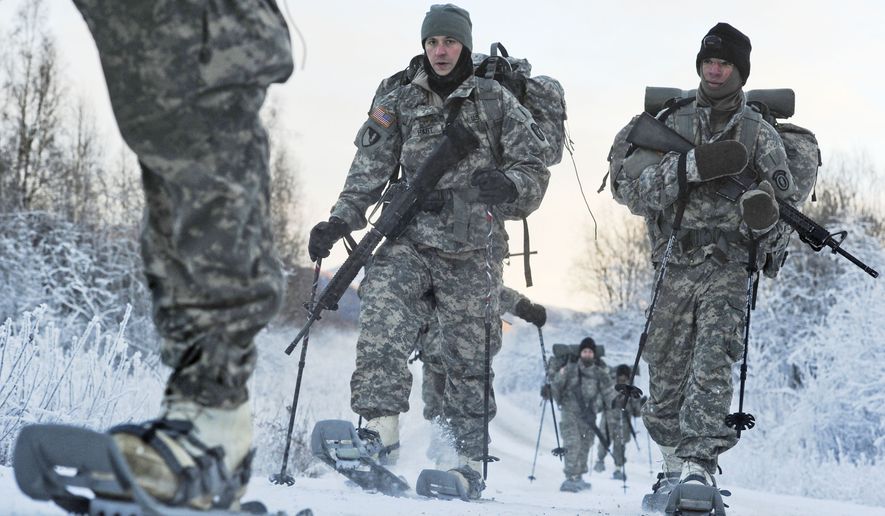Even as the U.S. military struggles to contain the Islamic State and deals with other terrorist threats across the globe, President Obama increasingly is recruiting the Pentagon to advance his sweeping climate change agenda.
Mr. Obama’s Defense Department calls global warming a true national security threat and has begun instituting a host of environmental measures, ranging from building clean energy projects at military installations to the use of expensive green fuels in planes.
A recent report from the Government Accountability Office highlighted yet another example — the commitment of U.S. military forces to monitor sea ice levels in the Arctic, with the administration arguing that decreasing ice could force the Pentagon to institute a “military and homeland security presence in the region.”
Critics charge the president is distracting the military from its true mission of protecting America by turning the Department of Defense into yet another weapon in his fight against climate change. But Mr. Obama has made no apologies for his environmental philosophy and has cast global warming as one of the top problems facing the Pentagon in the 21st century, a position many top Defense Department officials seem to agree with.
“I am here today to say that climate change constitutes a serious threat to global security, an immediate risk to our national security and, make no mistake, it will impact how our military defends our country. And so we need to act — and we need to act now,” the president told U.S. Coast Guard Academy graduates last month, laying out his vision for a military that focuses as much on climate change as it does on virtually any other threat.
Making the military greener is just one piece of Mr. Obama’s broader environmental agenda. In perhaps the most vital piece of the plan, the Environmental Protection Agency will, by the end of summer, release final carbon regulations for existing power plants — a proposal that will drive up electricity prices, government data show.
SEE ALSO: Climate change, doubt of Obama risk trade deal
The White House on Monday tried once again to justify its climate change goals by unveiling a new report claiming tens of thousands of lives will be saved through carbon restrictions and other policies. The report comes as Republicans on Capitol Hill take aim at the EPA budget and look to restrict the president’s global warming agenda through funding cuts.
So far the administration has been undaunted by complaints from Congress, legal challenges, reports of economic harm from climate policies and other obstacles.
Even before the president warned graduating Coast Guard officers about climate change, the Pentagon last fall released the “Climate Change Adaptation Roadmap,” a sweeping document that said global warming will affect military weapons systems, maintenance plans, transportation routes, stormwater management facilities, drinking water resources and a host of other military components.
Meanwhile, American forces also are being used to conduct research into the effects of climate change.
A recent Government Accountability Office report examined the Defense Department’s role in the Arctic, which increasingly will include “monitoring the changing Arctic conditions,” such as ice levels.
The administration contends that changing ice levels in the Arctic could require additional U.S. military presence in the region, justifying the need for the Pentagon to commit significant time and resources to monitoring the effects of climate change.
“Difficulty in developing accurate sea ice models, variability in the Arctic’s climate, and the uncertain rate of activity in the region create challenges for DOD to balance the risk of having inadequate capabilities or insufficient capacity when required to operate in the region with the cost of making premature or unnecessary investments,” reads a portion of the study, which was released Friday. “DOD plans to mitigate this risk by monitoring the changing Arctic conditions to determine the appropriate timing for capability investments.”
Other examples of the military embracing Mr. Obama’s climate goals include the construction of a massive solar power project at Fort Benning, Georgia, and the Navy’s move toward a “green fleet” that is far less reliant on fossil fuels.
Opponents say the administration, under the guise of protecting the environment for future generations, is saddling the military with unnecessary work and potentially putting at risk U.S. national security.
“It’s kind of a sad commentary that the military is going along with it without any pushback. And it’s ridiculous that the secretary of the Navy is running around talking about the great ’green fleet’ while the Chinese are basically building artificial islands in the Pacific so they can launch invasions against the Philippines, Japan and Korea,” said Michael McKenna, president of the lobbying firm MWR Strategies and a former Energy Department official. “Considering global warming as an important national security threat is just laughable.”
Many lawmakers on Capitol Hill have voiced similar criticism and say Mr. Obama is foolish to equate climate change with the Islamic State and other true threats to American interests.
“The president’s speech … is a severe disconnect from reality,” Sen. James M. Inhofe, Oklahoma Republican and chairman of the Senate Committee on Environment and Public Works, said last month after the president’s Coast Guard address.
But barring a major course correction by the next administration, the Pentagon will make climate change a central part of all future planning.
“Politics or ideology must not get in the way of sound planning,” then-Defense Secretary Chuck Hagel wrote in the Pentagon’s climate road map. “By taking a proactive, flexible approach to assessment, analysis and adaptation, the Defense Department will keep pace with a changing climate.”
• Ben Wolfgang can be reached at bwolfgang@washingtontimes.com.




Please read our comment policy before commenting.